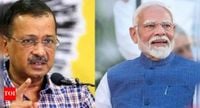In a week marked by fiery exchanges and sharp political jabs, India’s capital has become the stage for a heated debate over economic nationalism and political authenticity. On September 22, 2025, Arvind Kejriwal, the chief minister of Delhi and leader of the Aam Aadmi Party (AAP), openly mocked Prime Minister Narendra Modi on the social media platform X, accusing him of double standards in his push for Swadeshi—India’s homegrown products movement. Kejriwal’s critique came in the wake of Modi’s national address the previous day, where the prime minister called on the public to boycott foreign goods and embrace local alternatives as a path to self-reliance, especially after US President Donald Trump slapped a hefty 50 percent tariff on Indian exports.
Kejriwal’s post struck a chord with many and quickly gained traction online. “Prime Minister ji, you want the public to use Swadeshi. Will you yourself start using Swadeshi? Will you give up that foreign aeroplane you roam around in every day? Will you give up all the foreign goods you use throughout the day?” Kejriwal wrote, as reported by Kashmir Media Service and corroborated by several national outlets. The Delhi leader didn’t stop there—he went on to urge Modi to take concrete action against foreign influence, specifically asking, “Will you shut down the four American companies operating in India? Trump is insulting India and Indians every day. Won't you do something too? People expect action from their Prime Minister, not sermons.”
This pointed criticism was not an isolated incident. It followed on the heels of Modi’s impassioned plea to the nation on September 21, where he stated, “We need to make every home a symbol of Swadeshi, every shop should be adorned with Swadeshi products.” Modi’s address, delivered against the backdrop of escalating trade tensions with the United States, was intended to galvanize public support for homegrown industries. However, it quickly became a lightning rod for opposition parties, who accused the prime minister of hypocrisy and questioned the sincerity of his message.
The controversy was further stoked by AAP Member of Parliament Sanjay Singh, who leveled additional allegations against Modi’s personal lifestyle choices. In an interview with ANI, Singh remarked, “PM Modi wears glasses from Italy, a watch from Switzerland, uses a phone from America, uses cars from Germany, and is loaded on foreign brands, and yet he tells people to use Swadeshi products.” Singh went on to highlight the contradiction between the government’s public rhetoric and its ongoing trade practices: “It is a matter of regret that the country now faces a Prime Minister who has crippled the economy, broken the back of the common man, and even crippled foreign policy.”
The timing of these exchanges was no coincidence. Modi’s Swadeshi appeal came just as the newly approved Goods and Services Tax (GST) reforms took effect on September 22, coinciding with the start of Shardiya Navaratri—a period of religious and cultural significance that often sees a surge in consumer spending. The GST reforms, touted by the government as a step toward simplifying India’s complex tax regime and supporting local businesses, have been met with mixed reactions. Supporters argue that the changes will reduce bureaucratic hurdles and encourage entrepreneurship, while critics worry about the short-term disruptions and the burden on small traders.
Underlying the political theater is a deeper question about the feasibility of economic self-reliance in a globalized world. India, like many emerging economies, has long grappled with the tension between protecting domestic industries and engaging with international markets. The latest round of US tariffs—imposed by President Trump as part of his broader campaign to renegotiate trade deals—has put additional pressure on Indian exporters, particularly in sectors like textiles, pharmaceuticals, and information technology. Modi’s call for Swadeshi is, in part, a response to these external challenges, aimed at rallying national pride and reducing dependence on foreign goods.
Yet, as Kejriwal and his colleagues have pointed out, the reality on the ground is far more complicated. India’s economy is deeply intertwined with global supply chains, and many of the products used by both ordinary citizens and political leaders are manufactured abroad. From smartphones and luxury cars to everyday household appliances, foreign brands occupy a significant share of the Indian market. Even the very aircraft that ferry top government officials on state visits are often manufactured by American or European companies.
The opposition’s critique hinges on this apparent contradiction. By highlighting Modi’s use of imported goods, AAP leaders hope to underscore what they see as a gap between rhetoric and reality. Their argument is that genuine economic transformation requires more than symbolic gestures or public appeals—it demands consistent policy choices and personal example from those in power. As Sanjay Singh noted, “India continues to import goods worth crores from the US and China while the Prime Minister continued to call for the adoption of indigenous products.”
For many observers, the debate over Swadeshi is as much about political symbolism as it is about economic policy. Modi has long positioned himself as a champion of Indian self-reliance, drawing on the legacy of Mahatma Gandhi and other nationalist leaders who advocated for homegrown solutions during the country’s struggle for independence. The Swadeshi movement, once a rallying cry against colonial rule, has been repurposed in the modern era as a tool for economic development and national pride. But in an age of global commerce and digital connectivity, the boundaries between domestic and foreign are often blurred.
Meanwhile, the government has sought to defend its record, pointing to a range of initiatives aimed at boosting local manufacturing, supporting small businesses, and attracting foreign investment on India’s terms. Supporters of the administration argue that the prime minister’s call for Swadeshi is not an attack on globalization but a pragmatic response to shifting geopolitical realities. They contend that encouraging the use of Indian products can help create jobs, reduce the trade deficit, and strengthen the country’s bargaining position in international negotiations.
On the other side, critics maintain that the government’s approach is inconsistent and sometimes counterproductive. They argue that sudden policy shifts, such as the imposition of new tariffs or abrupt regulatory changes, can disrupt markets and undermine investor confidence. Furthermore, they question whether high-profile campaigns are a substitute for substantive reforms in areas like education, infrastructure, and innovation—sectors that are essential for long-term economic growth.
As the debate rages on, ordinary Indians are left to navigate the practical realities of daily life. For many, the choice between Swadeshi and foreign goods is less about ideology and more about price, quality, and availability. While some may be inspired by the call to support local businesses, others remain skeptical, citing concerns about affordability and access.
In the end, the clash between Kejriwal and Modi reflects broader tensions within Indian society—a struggle to balance national identity with the demands of a rapidly changing world. Whether the Swadeshi movement will translate into lasting economic change or remain a political slogan is a question that only time will answer. For now, the spotlight remains firmly on the country’s leaders, whose words and actions are under closer scrutiny than ever.




